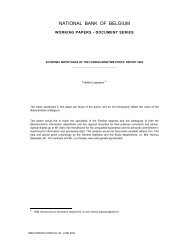A multi-factor model for the valuation and risk management of ...
A multi-factor model for the valuation and risk management of ...
A multi-factor model for the valuation and risk management of ...
You also want an ePaper? Increase the reach of your titles
YUMPU automatically turns print PDFs into web optimized ePapers that Google loves.
short rate (being <strong>the</strong> sum <strong>of</strong> <strong>the</strong> term structure <strong>factor</strong>s), <strong>the</strong> yield curve (being an a¢ ne function<br />
<strong>of</strong> <strong>the</strong> term structure <strong>factor</strong>s), <strong>the</strong> deposit rates <strong>of</strong> <strong>the</strong> eight banks (each being an a¢ ne function<br />
<strong>of</strong> <strong>the</strong> term structure <strong>and</strong> deposit spread <strong>factor</strong>), <strong>and</strong> deposit balance dynamics (depending on <strong>the</strong><br />
deposit rate dynamics <strong>and</strong> having a deterministic decaying component). As a result, a number <strong>of</strong><br />
daily 40-year simulation paths <strong>for</strong> <strong>the</strong> economic rents <strong>and</strong> discounted economic rents result under<br />
<strong>the</strong> <strong>risk</strong>-neutral probability measure. The deposit premium is <strong>the</strong>n set equal to <strong>the</strong> cumulative sum<br />
<strong>of</strong> discounted economic rents, averaged over all per<strong>for</strong>med simulations. Additionally, <strong>the</strong> di¤erent<br />
corresponding dynamics <strong>for</strong> all <strong>the</strong> above variables are being estimated after having shocked <strong>the</strong><br />
term structure <strong>factor</strong>s separately, each <strong>of</strong> <strong>the</strong>m resulting in a di¤erent average deposit premium<br />
estimate. The interest rate elasticity <strong>for</strong> <strong>the</strong> shock under consideration is <strong>the</strong>n set equal to <strong>the</strong><br />
change in deposit premium value over <strong>the</strong> shock that is imposed.<br />
For illustration purposes, Figure 8 shows <strong>the</strong> discounted economic rents earned by <strong>the</strong> bank over<br />
<strong>the</strong> next 40 years, as a percentage <strong>of</strong> outst<strong>and</strong>ing deposits <strong>and</strong> averaged over all simulation runs,<br />
where (i) <strong>the</strong> servicing cost is …xed at 0% <strong>of</strong> outst<strong>and</strong>ing balances 15 , (ii) <strong>the</strong> decay rate parameter<br />
is set to 15% per annum (corresponding to a halving time <strong>of</strong> 5.7 year), <strong>and</strong> where (iii) each term<br />
structure <strong>factor</strong> starts from its average value at each <strong>of</strong> <strong>the</strong> Monte Carlo simulation runs. Figure<br />
8 gives an idea about <strong>the</strong> timing at which economic rents are earned, evaluated at <strong>the</strong>ir present<br />
value <strong>and</strong> averaged across all simulation paths. The discounted rents decrease quasi-monotonically<br />
over time, which is in line with <strong>the</strong> pattern observed <strong>and</strong> reported by O’Brien (2000). The bulk <strong>of</strong><br />
all discounted rents is earned in a time span <strong>of</strong> 20 years (80 quarters). Figure 9 reports <strong>the</strong> same<br />
in<strong>for</strong>mation as Figure 8, but now expressed in a cumulative way. Quarter t discounted economic<br />
rents in Figure 8 can be interpreted as <strong>the</strong> quarter t slope <strong>of</strong> <strong>the</strong> curve in Figure 9. Observe that<br />
discounted economic rents converge to zero as we move fur<strong>the</strong>r in time, due to both <strong>the</strong> increasing<br />
discount rate <strong>and</strong> decaying balances, which is <strong>of</strong> course equivalent to <strong>the</strong> ‡attening out <strong>of</strong> <strong>the</strong><br />
cumulative discounted economic rents. The value to which cumulative discounted economic rents<br />
eventually converge (approx. 24% <strong>and</strong> 21% <strong>for</strong> Big 4 <strong>and</strong> medium-sized banks, respectively, in this<br />
illustration) corresponds to our de…nition <strong>of</strong> <strong>the</strong> deposit premium, P 0 =D 0 .<br />
Table 10 reports premium estimates P 0 =D 0 <strong>for</strong> individual banks, averaged over all simulations,<br />
where results are presented <strong>for</strong> <strong>the</strong> case where <strong>the</strong> decay rate is …xed at 15% <strong>and</strong> a 0% servicing<br />
cost. The average premium across all banks is 22.7% <strong>of</strong> outst<strong>and</strong>ing deposits.<br />
The last rows in Table 10 report estimated interest rate elasticities (IREs) with respect to each <strong>of</strong><br />
<strong>the</strong> term structure <strong>factor</strong>s, de…ned as:<br />
IRE <strong>factor</strong> i = dL 0<br />
L 0 df i (0)<br />
(25)<br />
i.e. <strong>the</strong> change in economic value that occurs when yield curve <strong>factor</strong> i is shocked with xbp, <strong>for</strong><br />
each bank (x is taken to be 100bp here, unless stated o<strong>the</strong>rwise). For example, averaged across<br />
banks, deposit liability values are estimated to decrease by 3.8% <strong>for</strong> every 100bp increase in <strong>the</strong><br />
level <strong>of</strong> <strong>the</strong> yield curve (see <strong>the</strong> IRE estimate <strong>for</strong> <strong>factor</strong> 1 <strong>for</strong> <strong>the</strong> average bank in Table 10).<br />
This is equivalent to saying that <strong>the</strong> deposit premium or net asset value <strong>of</strong> <strong>the</strong> deposit liability<br />
is estimated to increase by 3.8% when interest rates go up by 100bp. It is in this latter sense<br />
that deposit accounts are said to o¤set value losses on <strong>the</strong> asset side when interest rates increase.<br />
For <strong>the</strong> level <strong>factor</strong> (<strong>factor</strong> 1), <strong>the</strong> IRE (with a minus sign) can be understood as a proxy <strong>for</strong> <strong>the</strong><br />
modi…ed duration. 16<br />
15 See below where a vector <strong>of</strong> di¤erent values is considered <strong>for</strong> <strong>the</strong> servicing cost parameter. Servicing costs are<br />
usually expressed as a proportion <strong>of</strong> <strong>the</strong> deposit balance. O’Brien (2000) shows that <strong>the</strong> changes in <strong>the</strong> annual costs<br />
per deposit are small <strong>and</strong> unrelated to <strong>the</strong> deposit rate. He estimates r c (t) = c to be 1.2 p.c., 1.31 p.c. <strong>and</strong> 1.48<br />
p.c. <strong>for</strong> small, medium-sized <strong>and</strong> large NOW accounts <strong>and</strong> 0.75 p.c., 0.83 p.c. <strong>and</strong> 0.88 p.c. <strong>for</strong> MMDAs.<br />
16 This is not fully correct, as <strong>the</strong> imposed shock dies out <strong>and</strong> hence is not a truly permanent shock. However, <strong>the</strong><br />
mean reversion <strong>of</strong> <strong>the</strong> level <strong>factor</strong> is weak <strong>and</strong> <strong>the</strong> IRE can thus be interpreted as a modi…ed duration e¤ect.<br />
16
















